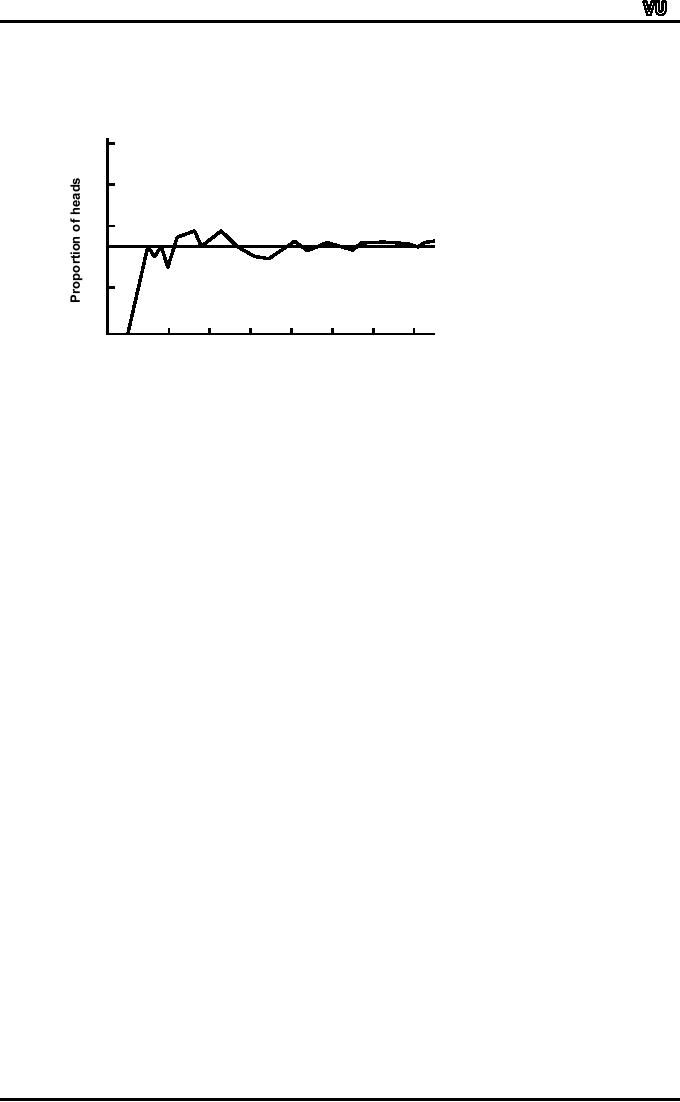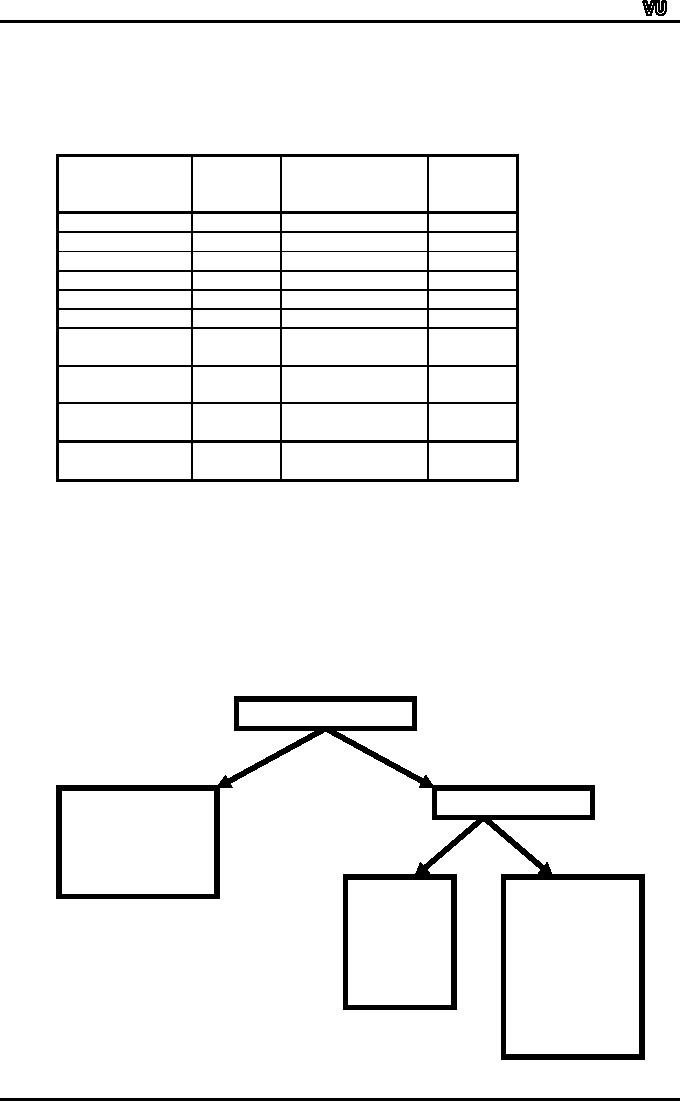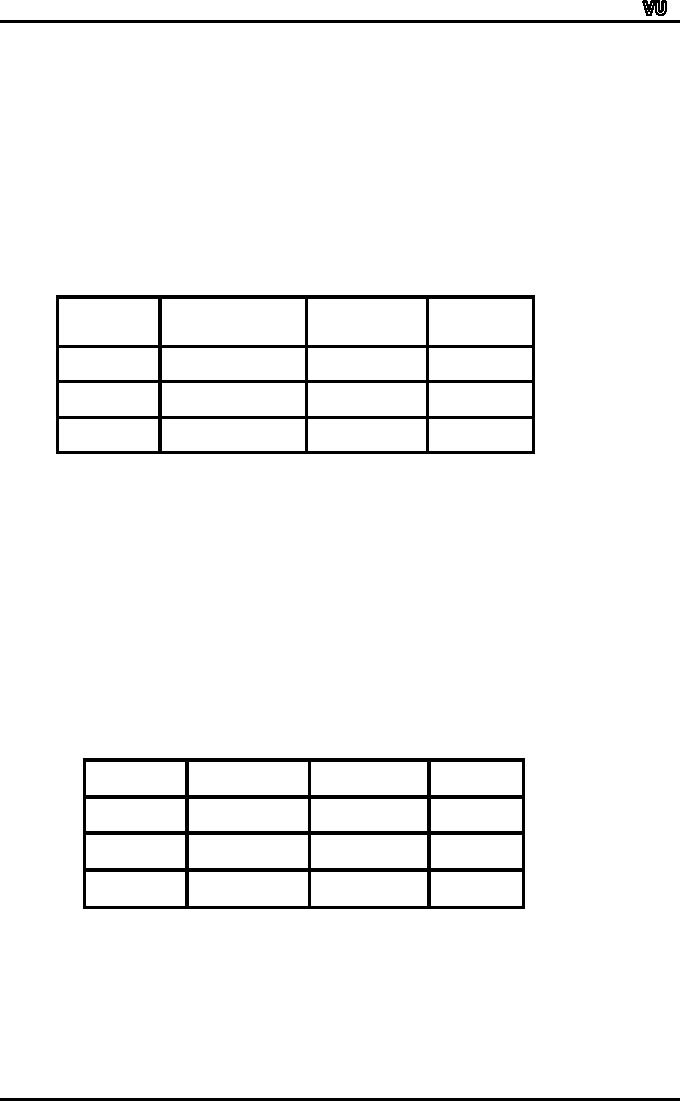 |

MTH001
Elementary Mathematics
LECTURE #
31:
Relative
Frequency Definition of
Probability
�
Axiomatic
Definition of Probability
�
Laws
of Probability
�
�
Rule of
Complementation
�
Addition
Theorem
THE
RELATIVE FREQUENCY DEFINITION OF
PROBABILITY
(`A
POSTERIORI' DEFINITION OF
PROBABILITY):
If
a random experiment is repeated a
large number of times, say n
times, under
identical
conditions and if an event A is
observed to occur m times,
then the probability
of
the
event A is defined as the
LIMIT of the relative
frequency m/n as n tends to
infinitely.
Symbolically,
we write
m
P( A) = Lim
n
n→∞
The
definition assumes that as n
increases indefinitely, the
ratio m/n tends to become
stable
at
the numerical value P(A).
The relationship between
relative frequency and
probability can
also
be represented as follows:
Relative
Frequency →
Probability
as
n →
∞
As
its name suggests, the
relative frequency definition
relates to the relative
frequency with
which
are event occurs in the
long
run. In situations
where we can say that an
experiment
has
been repeated a very large
number of times, the
relative
frequency definition can
be
applied.
As
such, this definition is
very useful in those
practical situations where we
are
interested
in computing a probability in numerical
form but where the
classical definition
cannot
be applied.(Numerous real-life situations
are such where various
possible outcomes
of
an experiment are NOT
equally likely). This type
of probability is also called
empirical
probability
as it is based on EMPIRICAL
evidence
i.e. on OBSERVATIONAL
data.
It
can also be called
STATISTICAL
PROBABILITY for
it is this very probability
that forms
the
basis of mathematical
statistics.
Let
us try to understand this
concept by means of two
examples:
1)
from a coin-tossing experiment
and
2)
from data on the numbers of
boys and girls
born.
EXAMPLE-1:
Coin-Tossing:
No
one can tell which
way a coin will fall
but we expect the proportion
of leads and tails
after
a
large no. of tosses to be
nearly equal. An experiment to
demonstrate this point
was
performed
by Kerrich in Denmark in 1946. He
tossed a coin 10,000 times,
and obtained
altogether
5067 heads and 4933
tails.
The
behavior of the proportion of
heads throughout the
experiment is shown as in
the
following
figure:
Page
216

MTH001
Elementary Mathematics
The
proportion; of heads in a sequence of
tosses of a coin (Kerrich,
1946):
1.0
.8
.6
.5
.2
0
10
30
100
300
1000
3000
10000
3
Number
of tosses (logarithmic
scale)
As
you can see, the
curve fluctuates widely
at first,
but begins to settle down to
a more or
less
stable
value as
the number of spins
increases. It seems reasonable to
suppose that the
fluctuations
would continue to diminish if
the experiment were
continued indefinitely,
and the
proportion
of heads would cluster more
and more closely
about a
limiting
value
which would
be
very
near, if not
exactly, one-half.
This
hypothetical limiting
value is
the (statistical) probability of
heads.
Let
us now take an example
closely related to our
daily
lives
--- that relating to the
sex ratio:-
In
this context, the first
point to note is that it has
been known since the
eighteenth century
that
in reliable
birth
statistics based on sufficiently
large
numbers
(in at least some parts
of
the
world), there is always a
slight excess
of
boys,
Laplace
records that, among the
215,599 births in thirty
districts of France in the
years 1800
to
1802, there were 110,312
boys and 105,287
girls.
The
proportions of boys and
girls were thus 0.512
and 0.488 respectively
(indicating a slight
excess
of boys
over girls).In a smaller
number of
births one would, however,
expect
considerable
deviations
from
these proportions.
This
point can be illustrated
with the help of the
following example:
EXAMPLE-2:
The
following table shows the
proportions of male births
that have been worked
out for the
major
regions of England as well as
the rural districts of
Dorset (for the year
1956):
Page
217

MTH001
Elementary Mathematics
Proportions
of Male Births in various
Regions
and
Rural Districts of England in
1956
(Source:
Annual Statistical
Review)
Propo
rtio n
Propo
rtio n
Region
of
Rura
l Districts of
of
Ma le
of
Ma le
Eng
land
Do
rset
Births
Births
No
rthern
.514
Beaminste
r
.38
E.
& W. Riding
.513
Blandfo
rd
.47
No
rth Weste rn
.512
Bridpo
rt
.53
No
rth Midland
.517
Do
rcheste r
.50
Midland
.514
Shaftesbury
.59
Eastern
.516
She
rbo rne
.44
London
and S.
.514
Sturminste
r
.54
Eastern
Wa
re ham and
Southe
rn
.514
.53
Purbeck
Wimbo
rne &
South
Weste rn
.513
.54
Cranbo
rne
All
Rura l District's
Who
le country
.514
.512
of
Do rset
As
you can see, the
figures for the rural
districts of Dorset, based on
about 200 births
each,
fluctuate
between 0.38 and 0.59.
While those for the
major regions of England,
which are
each
based on about 100,000
births, do not fluctuate
much, rather, they range
between
0.512
and 0.517 only. The
larger sample size is
clearly the reason for
the greater constancy
of
the latter. We can imagine
that if the sample were
increased indefinitely, the
proportion of
boys
would tend to a limiting
value
which is unlikely to differ
much from 0.514, the
proportion
of
male births for the
whole
country.
This
hypothetical limiting
value is
the (statistical) probability
of a male
birth.
The
overall discussion regarding
the various ways in which
probability can be defined
is
presented
in the following
diagram:
Probability
Non-Quantifiable
Quantifiable
(Inductive,
Subjective
or
Personalistic
Probability)
"
A Priori "
Statistical
Probability
Probability
(Verifiable
(Empirical
or
through
"
A Posteriori "
Empirical
Probability)
↑
Evidence)
(A
statistician's
main
concern)
Page
218

MTH001
Elementary Mathematics
As
far as quantifiable
probability is
concerned, in those situations
where the various
possible
outcomes
of our experiment are
equally likely, we can
compute the probability
prior
to
actually
conducting the experiment
--- otherwise, as is generally
the case, we can
compute
a
probability only after
the
experiment has been
conducted (and this is why
it is also called
`a
posteriori' probability).
Non-quantifiable
probability is the one that
is called Inductive
Probability.
It
refers to the degree of
belief which it is reasonable to
place in a proposition on given
evidence.
An
important point to be noted is
that it is difficult to express
inductive probabilities
numerically
to construct a numerical scale
of inductive probabilities, with 0
standing for
impossibility
and for logical certainty.
An important point to be noted is
that it is difficult to
express
inductive probabilities numerically
to construct a numerical scale
of inductive
probabilities,
with 0 standing for
impossibility and for
logical certainty.
Most
statisticians have arrived at
the conclusion that
inductive probability cannot, in
general,
he
measured and, therefore
cannot be use in the
mathematical theory of
statistics.
This
conclusion is not, perhaps,
very surprising since there
seems
no
reason why rational degree
of belief should be measurable
any more than, say,
degrees
of
beauty. Some paintings are
very beautiful, some are
quite beautiful, and some
are ugly,
but
it would be observed to try to
construct a numerical scale of
beauty, on which Mona
Lisa
had
a beauty value of 0.96.Similarly
some propositions are highly
probable, some are
quite
probable
and some are improbable,
but it does not seem
possible to construct a
numerical
scale
of such (inductive) probabilities
.Because of the fact that
inductive probabilities are
not
quantifiable
and cannot be employed in a
mathematical argument, this is
the reason why
the
usual
methods of statistical inference
such as tests of significance
and confidence
interval
are
based entirely on the
concept of statistical probability.
Although we have
discussed
three
different ways of defining
probability, the most formal
definition is yet to
come.
This
is The Axiomatic Definition of
Probability.
THE
AXIOMATIC DEFINITION OF
PROBABILITY:
This
definition, introduced in 1933 by
the Russian
mathematician
Andrei
N. Kolmogrov, is based on a set of
AXIOMS.
Let
S be a sample space with the
sample points E1, E2, ...
Ei, ...En. To each sample
point,
we
assign a real number,
denoted by the symbol P(Ei),
and called the probability
of Ei, that
must
satisfy the following basic
axioms:
Axiom
1:
For
any event Ei,
0
< P(Ei) < 1.
Axiom
2:
P(S)
=1
for
the sure event S.
Axiom
3:
If
A and B are mutually
exclusive events (subsets of
S), then
P
(A ∪
B) =
P(A) + P(B).
It
is to be emphasized that According to
the axiomatic theory of
probability:
SOME
probability defined as a non-negative
real number is to be ATTACHED to
each
sample
point Ei such
that the sum of all
such numbers must equal
ONE.
The
ASSIGNMENT of probabilities may be
based on past evidence or on
some other
underlying
conditions.
Page
219

MTH001
Elementary Mathematics
(If
this assignment of probabilities is
based on past evidence, we
are talking about
EMPIRICAL
probability, and if this
assignment is based on underlying
conditions that
ensure
that
the various possible
outcomes of a random experiment
are EQUALLY LIKELY, then
we
are
talking about the CLASSICAL
definition of probability.
Let
us consider another
example:
EXAMPLE
:
Table-1
below
shows the numbers of births
in England and Wales in 1956
classified by (a) sex
and
(b) whether liveborn or
stillborn.
Table-1
Number
of births in England and
Wales in 1956 by sex and
whether live- or still
born.
(Source
Annual Statistical
Review)
Livebo
rn
Stillbo
rn
Tota
l
Ma
le
359,881
(A)
8,609
(B )
368,490
F
emale
340,454
(B )
7,796
(D)
348,250
Tota
l
700,335
16,405
716,740
There
are four possible events in
this double
classification:
�
Male
livebirth (denoted by
A),
�
Male
stillbirth (denoted by
B),
�
Female
livebirth (denoted by C)
and
�
Female
stillbirth (denoted by
D),
The
relative frequencies corresponding to
the figures of Table-1 are
given in Table-2:
Table-2
Proportion
of births in England and
Wales in 1956 by sex and
whether live- or
stillborn.
(Source
Annual
Statistical Review)
Livebo
rn
Stillbo
rn
Tota
l
Ma
le
.5021
.0120
.5141
F
emale
.4750
.0109
.4859
Tota
l
.9771
.0229
1.0000
The
total number of births is
large enough for these
relative frequencies to be treated
for all
practical
purposes as PROBABILITIES.
Let
us denote the compound
events `Male birth' and
`Stillbirth' by the letters
M
and
S.Now a male birth occurs
whenever either a male
livebirth or a male stillbirth
occurs,
Page
220

MTH001
Elementary Mathematics
and
so the proportion of male
birth, regardless of whether
they are live-or stillborn,
is equal
to
the sum of the proportions
of these two types of birth;
that is to say,
p(M)
=
p(A or B) = p(A) +
p(B)
=
.5021 + .0120 = .5141
Similarly,
a stillbirth occurs whenever
either a male stillbirth or a
female stillbirth occurs
and
so
the proportion of stillbirths,
regardless of sex, is equal to
the sum of the proportions
of
these
two events:
p(S)
=
p(B or D) = p(B) +
p(D)
=
.0120 + .0109 =
.0229.
Let
us now consider some basic
LAWS of probability.
These
laws have important
applications in solving probability
problems.
LAW
OF COMPLEMENTATION:
If
⎯A
is the complement of an event A
relative to the sample space
S, then
P(A
) = 1
-
P( A).
Hence
the probability of the
complement of an event is equal to
one minus the probability
of
the
event.
Complementary
probabilities are very
useful when we are wanting
to solve
questions
of the type `What is the
probability that, in tossing
two fair dice, at least
one even
number
will appear?'
EXAMPLE:
A
coin is tossed 4 times in
succession. What is the
probability that at least
one head occurs?
(1)
The sample space S for
this experiment consists of 24 = 16
sample points (as each
toss
can
result in 2 outcomes),and
(2)
we assume that each outcome
is equally likely.
If
we let A represent the event
that at least one head
occurs, then A will
consist
of
MANY sample points, and the
process of computing the
probability of this event
will
become
somewhat cumbersome! So,
instead of denoting this
particular event by A, let
us
denote
its complement i.e. "No
head" by A.
Thus
the event A consists of the
SINGLE sample point
{TTTT}.
Therefore
P(A ) = 1/16.
Hence
by the law of complementation, we
have
P(A
)
= 1
-
P(A
)
= 1
-
1
15
= .
16
16
The
next law that we will
consider is the Addition Law
or the General Addition
Theorem of
Probability:
ADDITION
LAW:
If
A and B are any two
events defined in a sample
space S, then
P(A∪B)
= P(A) + P(B) P(A∩B)
In
words, this law may be
stated as follows:
"If
two events A and B are
not mutually exclusive, then
the probability that
at
least
one of them occurs, is given
by the sum of the separate
probabilities of events A
and
B
minus the probability of the
joint event A ∩
B."
Page
221
Table of Contents:
- Recommended Books:Set of Integers, SYMBOLIC REPRESENTATION
- Truth Tables for:DE MORGAN’S LAWS, TAUTOLOGY
- APPLYING LAWS OF LOGIC:TRANSLATING ENGLISH SENTENCES TO SYMBOLS
- BICONDITIONAL:LOGICAL EQUIVALENCE INVOLVING BICONDITIONAL
- BICONDITIONAL:ARGUMENT, VALID AND INVALID ARGUMENT
- BICONDITIONAL:TABULAR FORM, SUBSET, EQUAL SETS
- BICONDITIONAL:UNION, VENN DIAGRAM FOR UNION
- ORDERED PAIR:BINARY RELATION, BINARY RELATION
- REFLEXIVE RELATION:SYMMETRIC RELATION, TRANSITIVE RELATION
- REFLEXIVE RELATION:IRREFLEXIVE RELATION, ANTISYMMETRIC RELATION
- RELATIONS AND FUNCTIONS:FUNCTIONS AND NONFUNCTIONS
- INJECTIVE FUNCTION or ONE-TO-ONE FUNCTION:FUNCTION NOT ONTO
- SEQUENCE:ARITHMETIC SEQUENCE, GEOMETRIC SEQUENCE:
- SERIES:SUMMATION NOTATION, COMPUTING SUMMATIONS:
- Applications of Basic Mathematics Part 1:BASIC ARITHMETIC OPERATIONS
- Applications of Basic Mathematics Part 4:PERCENTAGE CHANGE
- Applications of Basic Mathematics Part 5:DECREASE IN RATE
- Applications of Basic Mathematics:NOTATIONS, ACCUMULATED VALUE
- Matrix and its dimension Types of matrix:TYPICAL APPLICATIONS
- MATRICES:Matrix Representation, ADDITION AND SUBTRACTION OF MATRICES
- RATIO AND PROPORTION MERCHANDISING:Punch recipe, PROPORTION
- WHAT IS STATISTICS?:CHARACTERISTICS OF THE SCIENCE OF STATISTICS
- WHAT IS STATISTICS?:COMPONENT BAR CHAR, MULTIPLE BAR CHART
- WHAT IS STATISTICS?:DESIRABLE PROPERTIES OF THE MODE, THE ARITHMETIC MEAN
- Median in Case of a Frequency Distribution of a Continuous Variable
- GEOMETRIC MEAN:HARMONIC MEAN, MID-QUARTILE RANGE
- GEOMETRIC MEAN:Number of Pupils, QUARTILE DEVIATION:
- GEOMETRIC MEAN:MEAN DEVIATION FOR GROUPED DATA
- COUNTING RULES:RULE OF PERMUTATION, RULE OF COMBINATION
- Definitions of Probability:MUTUALLY EXCLUSIVE EVENTS, Venn Diagram
- THE RELATIVE FREQUENCY DEFINITION OF PROBABILITY:ADDITION LAW
- THE RELATIVE FREQUENCY DEFINITION OF PROBABILITY:INDEPENDENT EVENTS